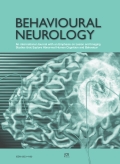Authors: Giovagnoli, Anna R. | da Silva, Antonio Martins | Federico, Antonio | Cornelio, Ferdinando
Article Type:
Research Article
Abstract:
Quality of life (QOL) is an important clinical endpoint, but it remarkably varies in patients with similar neurological conditions. This study explored the role of spirituality (i.e., the complex of personal transcendence, connectedness, purpose, and values) in determining QOL in chronic neurological disorders.~Seventy-two patients with epilepsy, brain tumours or ischemic or immune-mediate brain damage compiled inventories for QOL (WHOQOL 100), spirituality (Spiritual, Religious and Personal Beliefs, WHOSRPB), depression (Beck Depression Inventory, BDI),
…anxiety (State-Trait Anxiety Inventory, STAI), and cognitive self-efficacy (Multiple Ability Self-Report Questionnaire, MASQ) and underwent neuropsychological testing. With respect to 45 healthy controls, the patients reported worse QOL, with no difference between the four patient subgroups. Factor analyses of the WHOSRPB, STAI, and BDI scores and of the MASQ and neuropsychological test scores yielded four (Personal Meaning, Inner Energy, Awe and Openness, Mood) and three factors (Control Functions, Cognition, Memory), respectively. Mood, Cognition, Inner Energy, schooling, and subjective health status correlated with the WHOQOL scores, but at regression analysis only Mood and Inner Energy predicted QOL. This suggests that spirituality, as a personal dimension distinct from mood, contributes to determine QOL. A multidimensional assessment of QOL, including personal facets, may explain differences between patients with chronic neurological disorders.
Show more
Keywords: Quality of life, brain lesions, chronic neurological disorders, mood, spirituality, cognitive functions
DOI: 10.3233/BEN-2009-0243
Citation: Behavioural Neurology,
vol. 21, no. 3-4, pp. 155-163, 2009
Price: EUR 27.50





